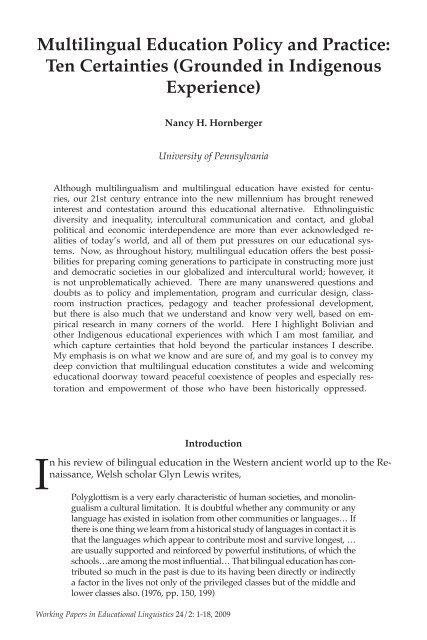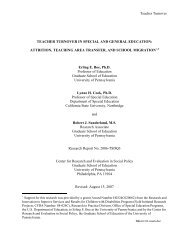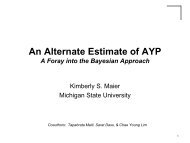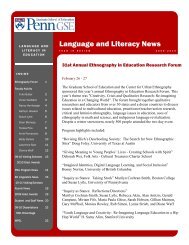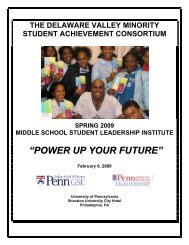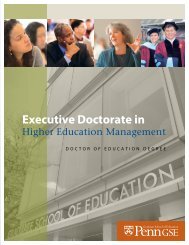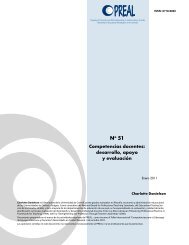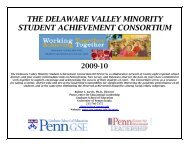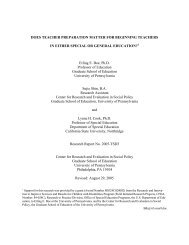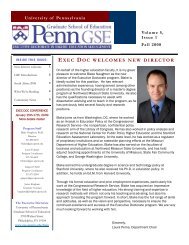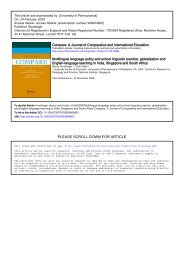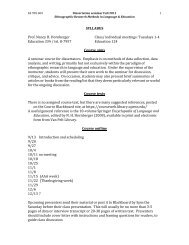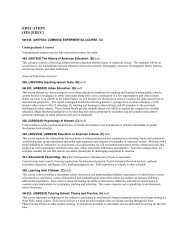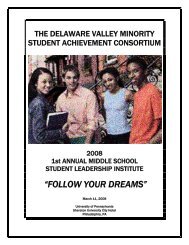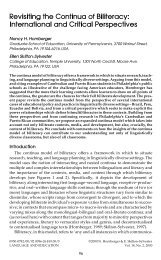Multilingual Education Policy and Practice - Penn GSE - University ...
Multilingual Education Policy and Practice - Penn GSE - University ...
Multilingual Education Policy and Practice - Penn GSE - University ...
Create successful ePaper yourself
Turn your PDF publications into a flip-book with our unique Google optimized e-Paper software.
<strong>Multilingual</strong> <strong>Education</strong> <strong>Policy</strong> <strong>and</strong> <strong>Practice</strong>:<br />
Ten Certainties (Grounded in Indigenous<br />
Experience)<br />
Nancy H. Hornberger<br />
<strong>University</strong> of <strong>Penn</strong>sylvania<br />
Although multilingualism <strong>and</strong> multilingual education have existed for centuries,<br />
our 21st century entrance into the new millennium has brought renewed<br />
interest <strong>and</strong> contestation around this educational alternative. Ethnolinguistic<br />
diversity <strong>and</strong> inequality, intercultural communication <strong>and</strong> contact, <strong>and</strong> global<br />
political <strong>and</strong> economic interdependence are more than ever acknowledged realities<br />
of today’s world, <strong>and</strong> all of them put pressures on our educational systems.<br />
Now, as throughout history, multilingual education offers the best possibilities<br />
for preparing coming generations to participate in constructing more just<br />
<strong>and</strong> democratic societies in our globalized <strong>and</strong> intercultural world; however, it<br />
is not unproblematically achieved. There are many unanswered questions <strong>and</strong><br />
doubts as to policy <strong>and</strong> implementation, program <strong>and</strong> curricular design, classroom<br />
instruction practices, pedagogy <strong>and</strong> teacher professional development,<br />
but there is also much that we underst<strong>and</strong> <strong>and</strong> know very well, based on empirical<br />
research in many corners of the world. Here I highlight Bolivian <strong>and</strong><br />
other Indigenous educational experiences with which I am most familiar, <strong>and</strong><br />
which capture certainties that hold beyond the particular instances I describe.<br />
My emphasis is on what we know <strong>and</strong> are sure of, <strong>and</strong> my goal is to convey my<br />
deep conviction that multilingual education constitutes a wide <strong>and</strong> welcoming<br />
educational doorway toward peaceful coexistence of peoples <strong>and</strong> especially restoration<br />
<strong>and</strong> empowerment of those who have been historically oppressed.<br />
Introduction<br />
In his review of bilingual education in the Western ancient world up to the Renaissance,<br />
Welsh scholar Glyn Lewis writes,<br />
Polyglottism is a very early characteristic of human societies, <strong>and</strong> monolingualism<br />
a cultural limitation. It is doubtful whether any community or any<br />
language has existed in isolation from other communities or languages… If<br />
there is one thing we learn from a historical study of languages in contact it is<br />
that the languages which appear to contribute most <strong>and</strong> survive longest, …<br />
are usually supported <strong>and</strong> reinforced by powerful institutions, of which the<br />
schools…are among the most influential… That bilingual education has contributed<br />
so much in the past is due to its having been directly or indirectly<br />
a factor in the lives not only of the privileged classes but of the middle <strong>and</strong><br />
lower classes also. (1976, pp. 150, 199)<br />
Working Papers in <strong>Education</strong>al Linguistics 24/2: 1-18, 2009
WPEL Vo l u m e 24, Nu m b e r 2<br />
Although multilingualism <strong>and</strong> multilingual education have existed for centuries,<br />
our 21st century entrance into the new millennium has brought renewed<br />
interest <strong>and</strong> contestation around this educational alternative. Ethnolinguistic<br />
diversity <strong>and</strong> inequality, intercultural communication <strong>and</strong> contact, <strong>and</strong> global<br />
political <strong>and</strong> economic interdependence are more than ever acknowledged realities<br />
of today’s world, <strong>and</strong> all of them put pressures on our educational systems.<br />
Now, as throughout history, multilingual education offers the best possibilities<br />
for preparing coming generations to participate in constructing more<br />
just <strong>and</strong> democratic societies in our globalized <strong>and</strong> intercultural world, but it<br />
is not unproblematically achieved.<br />
<strong>Multilingual</strong> education is, at its best, (1) multilingual in that it uses <strong>and</strong><br />
values more than one language in teaching <strong>and</strong> learning, (2) intercultural in<br />
that it recognizes <strong>and</strong> values underst<strong>and</strong>ing <strong>and</strong> dialogue across different lived<br />
experiences <strong>and</strong> cultural worldviews, <strong>and</strong> (3) education that draws out, taking<br />
as its starting point the knowledge students bring to the classroom <strong>and</strong> moving<br />
toward their participation as full <strong>and</strong> indispensable actors in society – locally,<br />
nationally, <strong>and</strong> globally.<br />
Beyond these fundamental characteristics, there are many unanswered questions<br />
<strong>and</strong> doubts surrounding multilingual education as to policy <strong>and</strong> implementation,<br />
program <strong>and</strong> curricular design, classroom instruction practices, pedagogy,<br />
<strong>and</strong> teacher professional development, but there is also much that we underst<strong>and</strong><br />
<strong>and</strong> know very well, based on empirical research in many corners of the world.<br />
<strong>Multilingual</strong> education is in its essence an instance of biliteracy, “in which communication<br />
occurs in two (or more) languages in or around writing” (Hornberger,<br />
1990, p. 213), <strong>and</strong> I here use my continua of biliteracy framework as implicit organizing<br />
rubric for considering some certainties about biliteracy contexts, media,<br />
development, <strong>and</strong> content in multilingual education policy <strong>and</strong> practice around<br />
the world (Hornberger, 1989, 2003; Hornberger & Skilton-Sylvester, 2000) 1 . I highlight<br />
Bolivian <strong>and</strong> other Indigenous educational experiences with which I am most<br />
familiar, <strong>and</strong> which capture certainties that hold beyond the particular instances I<br />
describe, as documented by a wealth of research by many scholars on cases from<br />
around the world <strong>and</strong> across time, only a few of which I can mention here. My<br />
emphasis is on what we know <strong>and</strong> are sure of, <strong>and</strong> my goal is to convey my deep<br />
conviction that multilingual education constitutes a wide <strong>and</strong> welcoming educational<br />
doorway toward peaceful coexistence of peoples <strong>and</strong> especially restoration<br />
<strong>and</strong> empowerment of those who have been historically oppressed.<br />
What do we know about contexts – <strong>and</strong> spaces – for multilingual education?<br />
I begin with a vignette from a bilingual classroom in Andean South America:<br />
At Kayarani, a new school building was inaugurated last year <strong>and</strong> the<br />
rooms are nice, with tables <strong>and</strong> chairs that can be set up for group work.<br />
Berta, a native of Tarija, has been teaching here for three years, implementing<br />
bilingual education under the 1994 Bolivian National <strong>Education</strong><br />
Reform. She began with her class from the start of their schooling; they<br />
are now in 2nd-3rd grade. The classroom is decorated with posters made<br />
by the teacher in Quechua, including models of a story, a poem, a song, a<br />
2
Mu lt i l i n g u a l Ed u c at i o n Po l i c y a n d Pr a c t i c e: Te n Ce rta i n t i e s<br />
recipe, a letter; as well as both the Quechua <strong>and</strong> Spanish alphabets, which<br />
the students recite for me later. Also on the wall is the class newspaper,<br />
Llaqta Qhapariy [Voice of the People], featuring an article in Quechua written<br />
by student Calestino about farmers’ wanting better prices for their<br />
potatoes, which constitute their community’s subsistence.<br />
A key provision of the 1994 Reform is the establishment of a library in<br />
every primary classroom of the nation, each stocked with a collection of<br />
80 books provided by the Ministry of <strong>Education</strong> through the auspices of<br />
UNESCO. Included are 6 Big Books in Spanish, 3 of them based on oral<br />
traditions in Quechua, Aymara, <strong>and</strong> Guarani, respectively: El Zorro, el<br />
Puma y los Otros [The Fox, the Puma, <strong>and</strong> the Others], La Oveja y el Zorro<br />
[The Sheep <strong>and</strong> the Fox], La Chiva Desobediente [The Disobedient Goat].<br />
The Big Books are approximately 18” x 24”, with large print text <strong>and</strong> colorful<br />
illustrations, such that the pictures can be seen by the whole class if<br />
the teacher holds the book up in front of the class in a reading circle. This<br />
classroom, too, has a library corner housing a small collection including a<br />
couple of Big Books, <strong>and</strong> the teacher calls on a child to come to the front<br />
of the class to read one of the Big Books aloud to his classmates. Later,<br />
after the class leaves for recess, a couple of the children notice my interest<br />
in the Big Books <strong>and</strong> gleefully hold the books up for a photo. (Kayarani,<br />
Bolivia, 14 August 2000) 2<br />
This vignette points to two certainties about multilingual education.<br />
First certainty: National multilingual language education policy opens up ideological<br />
<strong>and</strong> implementational spaces for multilingual education.<br />
Bolivia’s 1994 <strong>Education</strong> Reform sought to implant multilingual education,<br />
termed bilingual intercultural education (EIB), nationwide, incorporating all 30<br />
Bolivian Indigenous languages, beginning with the three largest – Quechua, Aymara,<br />
<strong>and</strong> Guarani (Albó 1995, 1997; Hornberger & López 1998; López & Küper<br />
2004). The new law massively exp<strong>and</strong>ed the reach of EIB, from 114 experimental<br />
schools in the early 1990s to more than 1,000 by the year 1997 <strong>and</strong> almost 3,000<br />
schools by 2002, accounting for 22% of the primary school population, <strong>and</strong> accompanied<br />
by dropping school desertion rates <strong>and</strong> rising graduation rates (Nucinkis<br />
2006, cited in Swinehart, 2007). The 1994 Reform clearly opened spaces for the<br />
practice of multilingual education, including actual physical spaces in schools <strong>and</strong><br />
classrooms, as in the Kayarani instance. This is not to say that these spaces are<br />
unproblematically accepted <strong>and</strong> adopted, however.<br />
Second certainty: Local actors may open up – or close down – agentive spaces for<br />
multilingual education as they implement, interpret, <strong>and</strong> perhaps resist policy initiatives.<br />
The Kayarani teacher depicted in the vignette actively embraced <strong>and</strong> creatively<br />
put into practice the Bolivian Reform’s multilingual pedagogy. Where multilingual<br />
education policies are in place, spaces like these are opened up for the<br />
implementation of multilingual education programs. Yet, in other rural Bolivian<br />
schools, untouched stacks of the Reform’s texts remain in locked cabinets in the director’s<br />
office <strong>and</strong> little effort has been made to implement EIB. Top-down policy<br />
is not enough: any policy may fail if there is no bottom-up, local support. This was<br />
3
WPEL Vo l u m e 24, Nu m b e r 2<br />
seen two decades earlier in the Andes, for example, in the case of the Experimental<br />
Bilingual <strong>Education</strong> Project in Puno, Peru, where despite observable classroom<br />
success in schools such as Kinsachata, national bilingual education policy nevertheless<br />
failed there <strong>and</strong> in other communities due to lack of support from parents<br />
<strong>and</strong> local leaders (Hornberger, 1987, 1988).<br />
Uptake of the Reform is by no means a foregone conclusion <strong>and</strong> a key factor<br />
in the Bolivian case has been popular participation via Indigenous Peoples’ <strong>Education</strong>al<br />
Councils (López, 2008). These Councils have been vigilant not only to extend<br />
<strong>and</strong> radicalize EIB as broadly <strong>and</strong> inclusively as possible, but also to defend<br />
it when Evo Morales’ new government threatened to sweep it away along with<br />
the previous administration’s neoliberal economic policies (see Third Certainty<br />
below). The Peoples’ Councils approached “key national Indigenous organizations<br />
<strong>and</strong> organized a single united Indigenous Front (Bloque Indígena) as the maximum<br />
expression of popular participation in Bolivia” (Luykx & López, 2008, p. 48).<br />
Among other things, they argued that the so-called neoliberal EIB reform had in<br />
fact been forced to adopt proposals from Indigenous leaders <strong>and</strong> organizations<br />
which predated neoliberal policies in Boliva <strong>and</strong> they brought sufficient social<br />
pressure to force the Morales government to include Indigenous representation in<br />
the drafting of the new education law (Luykx & López, 2008).<br />
In addition to popular participation <strong>and</strong> local communities, local educators<br />
at primary, secondary, <strong>and</strong> tertiary levels may themselves be the ones opening<br />
spaces for multilingual education. One of the most interesting, promising, <strong>and</strong><br />
potentially enduring developments in bilingual education in the Andes in the last<br />
few decades is the master’s program in bilingual intercultural education for Indigenous<br />
students at PROEIB Andes. The PROEIB Maestría (as it is called), housed<br />
at the <strong>University</strong> of San Simón in Cochabamba, Bolivia, is a consortium effort<br />
sponsored by Indigenous organizations, universities, <strong>and</strong> Ministries of <strong>Education</strong><br />
in six countries – Argentina, Bolivia, Chile, Colombia, Ecuador, <strong>and</strong> Peru; <strong>and</strong> with<br />
additional international funding from German Technical Assistance (GTZ), UNI-<br />
CEF, UNESCO, World Bank, <strong>and</strong> others. Impelled by the vision <strong>and</strong> energy of<br />
Peruvian sociolinguist Luis Enrique López, this program has opened up spaces for<br />
Indigenous rights <strong>and</strong> Indigenous education surpassing those initially envisioned<br />
even in the Reform. It is a case illustrating that “Local educators are not helplessly<br />
caught in the ebb <strong>and</strong> flow of shifting ideologies in language policies – they help<br />
develop, maintain, <strong>and</strong> change that flow” (Hornberger & Johnson, 2007, p. 527; see<br />
also Johnson, 2007).<br />
A second vignette from Bolivia introduces our third certainty:<br />
4<br />
It is the opening session of the four-day 7th Latin American Congress on Bilingual<br />
Intercultural <strong>Education</strong> (VII-EIB), sponsored by the Bolivian Ministry<br />
of <strong>Education</strong>, organized by PROEIB Andes, <strong>and</strong> convened in Cochabamba,<br />
Bolivia at Centro Portales, a cultural <strong>and</strong> educational foundation housed in<br />
the former home of Bolivian tin baron Simon Patiño. The six hundred mostly<br />
Indigenous delegates representing 24 countries sit <strong>and</strong> chat comfortably in<br />
the outdoor amphitheatre among gently dropping petals of the flowering<br />
jacar<strong>and</strong>á trees, awaiting the arrival of Bolivian Minister of <strong>Education</strong> Felix<br />
Patzi, who will give the opening address.<br />
After several introductions <strong>and</strong> greetings from conference sponsors<br />
<strong>and</strong> hosts, as well as a brief ceremony of burnt offering for an
Mu lt i l i n g u a l Ed u c at i o n Po l i c y a n d Pr a c t i c e: Te n Ce rta i n t i e s<br />
auspicious gathering, Patzi arrives <strong>and</strong> greets the delegates with a roll<br />
call of the two dozen-plus countries represented, a communicative act<br />
that serves to reinforce the shared sense of an important international<br />
gathering of Indigenous educational leaders. Patzi, an Aymara sociologist,<br />
goes on to speak at some length on decolonization <strong>and</strong> interculturality.<br />
He affirms that Indigenous peoples must decolonize education<br />
such that not only European but also Indigenous knowledges<br />
are included, that interculturality is not only about respect <strong>and</strong> tolerance<br />
for the other but also about democratizing cultures <strong>and</strong> equalizing<br />
cultural conceptions, <strong>and</strong> that the status of Indigenous languages<br />
must be raised by speaking them not just within their own communities,<br />
but beyond. (Cochabamba, Bolivia, 1 October 2006)<br />
Third certainty: Ecological language policies take into account the power relations among<br />
languages <strong>and</strong> promote multilingual uses in all societal domains.<br />
Among the decolonizing reforms introduced by Bolivia’s first Indigenous<br />
president, Evo Morales, since taking office in January 2006, is a new education<br />
law proposed by Patzi at the June 2006 Bolivian National Congress of <strong>Education</strong>.<br />
Named in honor of two early 20th century Bolivian Indigenous education reformers,<br />
Avelino Siñani <strong>and</strong> Elizardo Pérez, the proposed law has as its stated objective<br />
the construction of an education that is communitarian, decolonizing, scientific,<br />
productive, intracultural, intercultural, <strong>and</strong> plurilingual. Patzi had criticized the<br />
1994 Reform as being too focused on language rather than culture <strong>and</strong> epistemology,<br />
<strong>and</strong> of contemplating only a one-way interculturalism rather than a truly democratizing<br />
two-way equality among cultures.<br />
Yet, despite the Morales’ administration’s initial rhetoric about reversing<br />
all policies associated with the previous neoliberal administration (López, 2005,<br />
2008), the new proposed law is best seen as building upon <strong>and</strong> exp<strong>and</strong>ing the<br />
achievements of the existing bilingual intercultural education reforms rather than<br />
ab<strong>and</strong>oning them altogether. Certainly the emphasis on two-way interculturalism<br />
<strong>and</strong> its necessary complement, intraculturalism, were very much part of the practice<br />
of those who took up the 1994 Reform (e.g., Hornberger, 2000; Hornberger &<br />
Hult, 2008). PROEIB Andes founder López puts it this way:<br />
Before opening oneself to discussing relationships among diverse peoples,<br />
cultures, <strong>and</strong> identities, colonial oppression creates a necessity to<br />
first reaffirm oneself as Indigenous before opening oneself to the possibility<br />
of dialogue. Bolivian Indigenous leader Froilán Condori puts this<br />
clearly when he speaks of intraculturalism – that first there must be a<br />
strong phase of intraculturalism before undertaking dialogue among cultures.<br />
He affirms that we can’t speak as equals if I have always been told<br />
that mine is of no value, but the other’s is. (López interview, 26 June<br />
2005; translation mine)<br />
Opening up spaces for multilingual education is about taking into account<br />
all languages in the ecology <strong>and</strong> recognizing that those languages are situated in<br />
social spaces <strong>and</strong> contexts. Planning for any one language in a particular social<br />
space necessarily entails planning for all languages <strong>and</strong> social influences in that<br />
space; this is especially true in the case of planning for endangered or dominated<br />
5
WPEL Vo l u m e 24, Nu m b e r 2<br />
languages since the fortunes of any one language necessarily hinge on those of<br />
other languages in its context.<br />
In Bolivia, at one end of the spectrum, a June 2006 decree makes knowledge<br />
of an Indigenous language prerequisite for any public office (El bilingüismo, 2006).<br />
At the other end, the 2006 proposed <strong>Education</strong> law explicitly adds English to the<br />
multilingual education mix while maintaining a strong emphasis on Indigenous<br />
languages: All teachers are required to speak English as well as Spanish <strong>and</strong> an<br />
Indigenous language, <strong>and</strong> instruction is to be trilingual.<br />
Bolivia’s proposed new trilingual education could be seen as a step in the right<br />
direction for Bolivia’s increased presence on the world stage, since it includes English,<br />
the increasingly undisputed tool of access to a globalized world, along with<br />
Spanish <strong>and</strong> the Indigenous languages. On the other h<strong>and</strong>, language planning<br />
for the management of linguistic diversity, in Bolivia as elsewhere in the world, is<br />
susceptible to a linguistic hierarchy in which English threatens to overwhelm the<br />
linguistic ecological balance. Hult, for example, documents that, even a nation<br />
like Sweden, with a thirty-year track record of careful language planning for the<br />
management of linguistic diversity, is susceptible to the discourses of linguistic<br />
hierarchy which privilege English as global language, leaving little room for real<br />
attention to minority mother tongues, <strong>and</strong> many challenges ahead toward achieving<br />
a truly sustainable multilingualism (2007). Similarly, contributors to a recent<br />
volume on language policies in a wide array of Asian contexts address themselves<br />
to the question of whether the ever-more-intrusive English acquisition policies in<br />
Asian countries actually foster multilingualism <strong>and</strong> multiculturalism or merely<br />
legitimate the hegemony of English over other languages (Tsui & Tollefson, 2007).<br />
How much more challenging might achieving an ecological balance for sustainable<br />
multilingualism be for Bolivia, with fewer resources <strong>and</strong> less societal exposure<br />
to English?<br />
What do we know about media – <strong>and</strong> modalities – of multilingual education?<br />
I begin this section on the media of biliteracy with a third vignette, this time<br />
from a Māori immersion school in Aotearoa/New Zeal<strong>and</strong>.<br />
6<br />
We three – my colleague Stephen May of the <strong>University</strong> of Waikato, his<br />
colleague Karaitiana Tamatea, parent <strong>and</strong> former whanau [extended family]<br />
leader at the school, <strong>and</strong> I – enter the kura kaupapa Māori [Māori immersion<br />
school] following the traditional powhiri [protocol], which means<br />
that the assistant principal (in the principal’s absence) greets us with a<br />
chant while we are still outside the premises, <strong>and</strong> then we slowly enter,<br />
exchanging chants with her as we do. After a continuation of this protocol<br />
inside one of the classrooms where all 80 children (grades 1-6) are<br />
gathered for our visit, we are invited to a different room for refreshments.<br />
Because of the strict prohibition on the use of English anywhere on the<br />
school premises at all times, this is the only room where I, a non-Māori<br />
speaker, can have a conversation with teachers, staff, <strong>and</strong> leadership of<br />
the school.<br />
I am introduced to the current whanau leader. Here, as is the case for<br />
the 58 other kura kaupapa schools in Aotearoa/New Zeal<strong>and</strong>, the whanau<br />
has been indispensable in the establishment <strong>and</strong> existence of the kura kau-
Mu lt i l i n g u a l Ed u c at i o n Po l i c y a n d Pr a c t i c e: Te n Ce rta i n t i e s<br />
papa. The school exists in the first place only by initiative of the whanau;<br />
<strong>and</strong> only after two years of running the school themselves may they appeal<br />
for government recognition <strong>and</strong> support. This school was founded<br />
in 1995 <strong>and</strong> gained recognition <strong>and</strong> its own school building <strong>and</strong> grounds<br />
several years ago. The whanau leader asks me ‘What do you think of bilingual<br />
education?’ As I formulate my answer <strong>and</strong> engage in further dialogue<br />
with him, it suddenly dawns on me that for him, bilingual education<br />
<strong>and</strong> Māori immersion are opposites, while for me they are located on<br />
a continuum. Māori-only ideology is of such integral <strong>and</strong> foundational<br />
importance to Māori immersion that the use of two languages suggested<br />
by the term bilingual is antithetical to those dedicated to Māori revitalization.<br />
(Hamilton, Aotearoa/New Zeal<strong>and</strong>, 28 June 2002) 3<br />
This vignette points to two more certainties about multilingual education.<br />
Fourth certainty: Models of multilingual education instantiate linguistic <strong>and</strong><br />
sociocultural histories <strong>and</strong> goals in each context.<br />
As my conversation with the whanau leader made clear, Māori immersion is different<br />
from other bilingual education. Māori immersion is also different from Canadian<br />
French immersion. In the latter, English-speaking children are immersed in French,<br />
but later also take up reading <strong>and</strong> writing in English, usually beginning in third grade,<br />
in a 50-50% proportion. In contrast, when the Māori immersion movement started in<br />
the 1980s, Māori communities opted for exclusive use of Māori language in formal education<br />
– enforcing a total immersion model of multilingual education, in which use<br />
of the dominant language, English, is in principle prohibited within the school precincts,<br />
<strong>and</strong> the separation of languages is meant to be absolute <strong>and</strong> sequential between<br />
Māori in school <strong>and</strong> English in the surrounding environment (Hornberger, 2002; May,<br />
1999; May & Hill, 2008).<br />
These programmatic differences in Canadian <strong>and</strong> Māori immersion models, insofar<br />
as simultaneous vs. successive acquisition along the media of biliteracy, are based<br />
in different sociocultural <strong>and</strong> linguistic histories <strong>and</strong> goals in each context. The history<br />
of writing in Māori goes back to 1825, before New Zeal<strong>and</strong> became a nation. Nevertheless,<br />
Māori was prohibited from use in school <strong>and</strong> was on the way to extinction<br />
when revitalization efforts began in the 1980s; the immersion schools were a key component<br />
of those revitalization efforts. The initiative taken by Māori elders <strong>and</strong> parents<br />
in Aotearoa/New Zeal<strong>and</strong> in the 1980s to establish pre-school language nests, kōhanga<br />
reo, to teach their children the ancestral language that was being replaced by English<br />
<strong>and</strong> in danger of disappearing, was a crucial step toward Māori language revitalization.<br />
That initiative gradually exp<strong>and</strong>ed <strong>and</strong> today encompasses Māori-medium education<br />
at all levels as well as official status for the language since 1987 (May, 1999, 2002;<br />
May & Hill, 2008), overseen by national level bodies such as the <strong>Education</strong> Review<br />
Office, which takes up both status <strong>and</strong> corpus concerns.<br />
Fifth certainty: Language status planning <strong>and</strong> language corpus planning go h<strong>and</strong> in<br />
h<strong>and</strong>.<br />
The aims of Māori-medium education have been first <strong>and</strong> foremost the revitalization<br />
of the language, at which considerable success has been achieved;<br />
7
WPEL Vo l u m e 24, Nu m b e r 2<br />
only more recently has a complementary focus on the educational effectiveness of<br />
Māori-medium education begun to emerge (May & Hill, 2008), while simultaneously,<br />
there has been a growing recognition of the importance of Māori language<br />
revitalization efforts not only in formal education but also in home <strong>and</strong> community<br />
(Hohepa, 2006).<br />
Literacy has been acknowledged to play an integral role in Indigenous language<br />
revitalization, or regeneration, as Māori scholar <strong>and</strong> parent Margie Hohepa prefers to<br />
call it since regeneration suggests “growth <strong>and</strong> regrowth, development <strong>and</strong> redevelopment”<br />
(M. Hohepa, 2006, p. 294; following her linguist father’s usage, cf. P. Hohepa,<br />
2000). In her estimation, print literacy in the Indigenous language validates <strong>and</strong> gives<br />
status to the language, supports the preservation of past traditions for future generations,<br />
ensures a wider variety of functions for the language, <strong>and</strong> recreates the language<br />
within a changing culture <strong>and</strong> society (M. Hohepa, 2006, p. 295).<br />
Print literacy <strong>and</strong> the use of a language in teaching <strong>and</strong> learning imply a writing<br />
system, st<strong>and</strong>ardized grammar, <strong>and</strong> elaborated vocabulary. If these do not exist, they<br />
must be developed. Planning for a language’s status as medium of education <strong>and</strong> developing<br />
its corpus for those uses go h<strong>and</strong> in h<strong>and</strong> (Fishman, 1979). Examples abound<br />
of the challenges involved, from China’s efforts to provide writing systems <strong>and</strong> multilingual<br />
education for 55 minority nationalities, of which 42 have no writing system<br />
(Zhou, 2001); to the ongoing concerns around st<strong>and</strong>ardization of Quechua in Peru,<br />
Bolivia, <strong>and</strong> Ecuador (e.g. Cerrón-Palomino, 1992; Coronel-Molina, 2007, 2008; Hornberger<br />
& Coronel-Molina, 2004; Hornberger & King, 1998; King, 2001); <strong>and</strong>, in these<br />
cases <strong>and</strong> others, also the challenge of professional development for teachers in writing<br />
hitherto unwritten languages that will be used in school. These “problems in the<br />
socio-educational legitimization of languages/varieties” have always accompanied<br />
the introduction of vernacular languages into education (Fishman, 1982, p. 4). The<br />
challenges are neither rare, unexpected, nor insuperable. We have many evidences of<br />
successfully completed <strong>and</strong> in-progress production of educational <strong>and</strong> print literacy<br />
materials for Māori <strong>and</strong> other Indigenous languages around the world, for example<br />
PRAESA’s Little H<strong>and</strong>s <strong>and</strong> Stories Across Africa projects (Bloch, 2008, 2009), <strong>and</strong> the<br />
Ithuba book project (Sailors & Hoffman, 2008), both in South Africa (see also Châtry–<br />
Komarek, 1987, 1996, 2003 for an authoritative treatment of this topic).<br />
A fourth vignette, from a site of multilingual Indigenous teacher education in<br />
Amazonian Brazil, introduces our sixth certainty:<br />
Every year since 1983, an Indigenous teacher education course sponsored<br />
by the Comissão Pró-Indio do Acre (CPI) has been held during the summer<br />
months (January-March) in the Amazonian rainforest of Brazil. The<br />
1997 session is attended by some 25 professores indios [Indigenous teachers],<br />
representing eight different ethnic groups whose languages are in<br />
varying stages of vitality, from those with about 150 speakers to those<br />
with several thous<strong>and</strong>. One of the striking features of the course is that<br />
the professores indios are simultaneously learners <strong>and</strong> teachers-in-formation;<br />
that is, they are simultaneously learning the school curriculum<br />
themselves for the first time, while also preparing themselves to return to<br />
their aldeias [communities] to teach it.<br />
Another feature of the course is the mutual multilingual underst<strong>and</strong>ing<br />
among the professores, in that the Indigenous languages are not only<br />
encouraged <strong>and</strong> used as medium <strong>and</strong> subject of instruction in the course<br />
8
Mu lt i l i n g u a l Ed u c at i o n Po l i c y a n d Pr a c t i c e: Te n Ce rta i n t i e s<br />
<strong>and</strong> later in their own schools, but also the professores encourage <strong>and</strong><br />
exchange among each other across their different languages. Although<br />
they do not necessarily speak or underst<strong>and</strong> all the other languages spoken<br />
<strong>and</strong> written by their peers, they read, listen, <strong>and</strong> look at each other’s<br />
work. To facilitate mutual underst<strong>and</strong>ing, they at times use Portuguese<br />
as lingua franca, at times draw on the geometric designs <strong>and</strong> illustrations<br />
that are an integral part of their writing, <strong>and</strong> at times simply rely on their<br />
shared intra/inter-ethnic experiences. One activity in which these features<br />
converge is in their authorship of teaching materials in the Indigenous<br />
languages which are reflective of Indigenous culture, history, <strong>and</strong><br />
artistic expression. These materials serve as documentation of the teachers’<br />
own learning while also later serving as a teaching resource for their<br />
own classrooms. (Rio Branco, Brazil, 23 January 1997) 4<br />
Sixth certainty: Communicative modalities encompass more than written <strong>and</strong> spoken<br />
language.<br />
The multimodal, multilingual, mutual comprehension among the Amazonian<br />
Indigenous teachers is particularly striking given the great diversity of languages<br />
in the group <strong>and</strong> the salience of multimodal drawing <strong>and</strong> geometric design in<br />
their writing practices. Each written assignment bears the complex <strong>and</strong> colorful<br />
geometric designs <strong>and</strong> maps that are, as Monte (1996, 2003) <strong>and</strong> Menezes de Souza<br />
(2005) demonstrate, not merely illustrations to accompany the alphabetic text, but<br />
integral complements to it; <strong>and</strong> these multimodal expressions contribute to the<br />
Indigenous teachers’ mutual underst<strong>and</strong>ing across language differences as well as<br />
to the development of their writing in those languages <strong>and</strong> in Portuguese.<br />
A similarly multilingual <strong>and</strong> multimodal ecology of languages characterizes<br />
classroom practices at the PROEIB Andes Maestría, in ways that strengthen each<br />
individual participant’s linguistic repertoire while simultaneously fostering peer<br />
interaction <strong>and</strong> cooperative learning, or interaprendizaje (López interview, 26 June<br />
2005), as shown below.<br />
What do we know about the development – <strong>and</strong> transfer – of language <strong>and</strong><br />
literacy in multilingual education?<br />
I begin this section on the development of biliteracy with a vignette from<br />
a workshop on ethnographic methods with the 42 students in the Maestría’s<br />
fourth cohort. The Maestría faculty practice <strong>and</strong> promote an ethnographic, social<br />
constructivist, <strong>and</strong> interpretive research orientation, which goes against<br />
the grain of more positivist academic traditions at San Simón <strong>and</strong> other universities<br />
in Latin America (<strong>and</strong> the world). Knowing my own research experience<br />
in the Andes <strong>and</strong> my continuing commitment to ethnographic research,<br />
the faculty had asked me to conduct workshops on ethnographic research, first<br />
with the faculty themselves, <strong>and</strong> subsequently with the students. In this session,<br />
I asked the students to collaboratively analyze a two-page excerpt from<br />
an interview in Quechua <strong>and</strong> Spanish.<br />
The Maestría students formed four groups of 7-8 each, making sure there were<br />
one to two Quechua speakers in each group. The task was to describe, analyze,<br />
9
10<br />
WPEL Vo l u m e 24, Nu m b e r 2<br />
<strong>and</strong> interpret a segment of the interview, following guidelines I had presented<br />
earlier. I used a transcript from my recent interview with Justo Ramos in Kinsachata,<br />
22 years after my initial study of bilingual education there when he was<br />
a 5th grader. There turned out to be a wide range of approaches in the four<br />
groups. One group in particular seemed very efficient <strong>and</strong> focused, moving systematically<br />
through the steps of segmenting the transcript, choosing a segment<br />
to analyze, applying some of the tools of discourse analysis <strong>and</strong> then Hymes’<br />
(1974, pp. 53–62) SPEAKING heuristic. In my observation, they were helped<br />
by the fact that one of them had taken very clear notes on my lecture in Spanish<br />
<strong>and</strong> referred to them throughout <strong>and</strong> another was able to read <strong>and</strong> interpret the<br />
Quechua fluently <strong>and</strong> quickly.<br />
In contrast, two of the groups seemed to get bogged down in the task of<br />
literally reading <strong>and</strong> translating the transcript, before they could get to work<br />
on the assigned task. This made me partly regret that I gave them a transcript<br />
with so much Quechua, but the combination of Quechua <strong>and</strong> Spanish<br />
provided rich material for analysis in terms of code-switching <strong>and</strong> use of<br />
linguistic resources. To their credit, both these groups persisted, asking me<br />
lots of questions, <strong>and</strong> I think actually learned a lot even though they didn’t<br />
get ‘as far’ as the first group.<br />
The last group also made good progress <strong>and</strong> had some excellent interpretive<br />
insights. They asked, for example, whether Justo himself had been in<br />
the bilingual education program, since he makes reference to his own writing<br />
in Quechua. In fact he had not, but their question points to an interesting<br />
insight, in that Justo’s younger siblings were in the bilingual program in his<br />
school while he was there in an upper grade, <strong>and</strong> through them, he may<br />
have picked up some Quechua reading/writing <strong>and</strong> exposure to Quechua<br />
texts. This information is not explicit in the transcript, but their analysis led<br />
them to infer that it might have been the case, perhaps a reflection of their<br />
own experience transferring Spanish reading <strong>and</strong> writing to Quechua reading<br />
<strong>and</strong> writing fairly readily. (Cochabamba, Bolivia, 11 September 2004)<br />
This vignette, <strong>and</strong> the Brazilian one above, point to a seventh certainty about<br />
multilingual education.<br />
Seventh certainty: Classroom practices can foster transfer of language <strong>and</strong> literacy<br />
development along receptive-productive, oral-written, L1-L2 dimensions <strong>and</strong> across<br />
modalities.<br />
The workshop interaction exemplifies some of the ways the Maestría students’<br />
classroom practices regularly enabled them to draw from across their<br />
multiple languages <strong>and</strong> literacies in accomplishing academic tasks collaboratively.<br />
Three PROEIB Maestría participants have written specifically about<br />
strategies of interdialectal communication in Quechua within PROEIB (Luykx,<br />
Julca, & García, 2006); <strong>and</strong> there is a rich repertoire of strategies for multilingual<br />
communication as well.<br />
Such hybrid multilingual classroom practices, recently <strong>and</strong> eloquently theorized<br />
<strong>and</strong> documented as translanguaging practices (Baker, 2003; Creese & Blackledge,<br />
2008; García, 2007, 2008), or bilingual supportive scaffolding practices (Saxena,<br />
2008), offer the possibility for teachers <strong>and</strong> learners to access academic content<br />
through the linguistic resources they bring to the classroom while simultaneously<br />
acquiring new ones. These biliteracy practices incorporate aspects of what have
Mu lt i l i n g u a l Ed u c at i o n Po l i c y a n d Pr a c t i c e: Te n Ce rta i n t i e s<br />
also been referred to in earlier bilingualism literature as passive bilingualism, receptive<br />
bilingualism, <strong>and</strong> dual lingualism (Lincoln, 1975).<br />
Theses of the Maestría provide further evidence of the productive multilingual,<br />
multimodal mix that nurtures these Indigenous educators in their pursuit of graduate<br />
studies. In addition to various theses exploring Indigenous language use, identities,<br />
<strong>and</strong> ideologies in classroom <strong>and</strong> community, or the production of written texts in Indigenous<br />
languages, a number of theses explore other communicative modes in the<br />
Indigenous repertoire, including textile weaving (Castillo Collado, 2005) <strong>and</strong> the traditional<br />
Andean musical form, huayño (Tito Ancalle, 2005); <strong>and</strong> one student wrote her<br />
entire thesis in Quechua, in an explicit act of language planning designed to explode<br />
the myth that it cannot be done <strong>and</strong> show that it is indeed possible to extend the use of<br />
Quechua to new domains, <strong>and</strong> to exp<strong>and</strong> Quechua vocabulary in authentic contexts,<br />
i.e., to intellectualize the language (cf. Garvin, 1974).<br />
What do we know about content – <strong>and</strong> identities – in multilingual education?<br />
This last section, on the content of biliteracy, begins with a last vignette, also<br />
from the PROEIB Andes workshop on ethnographic research methods.<br />
My final unit with the 42 students was on the Indigenous research agenda<br />
proposed by Māori researcher Linda Tuhiwai Smith in her book Decolonizing<br />
methodologies (1999). She talks in terms of 4 “tides” or conditions in which Indigenous<br />
people live – survival, recovery, development, <strong>and</strong> self-determination; 4<br />
directions or processes through which they move – healing, decolonization, mobilization,<br />
<strong>and</strong> transformation; <strong>and</strong> 25 projects they undertake, such as reclaiming,<br />
renaming, remembering, revitalizing, networking. I wasn’t sure how this<br />
would go over, but I guessed it might be very interesting for these Indigenous<br />
educators learning to be researchers.<br />
They were extremely attentive, taking notes as I presented this Indigenous<br />
agenda <strong>and</strong> although there was not a lot of discussion, there were clear moments<br />
of resonance <strong>and</strong> response. For example: (1) Connecting – in the sense<br />
of connecting people to each other <strong>and</strong> to the earth – the students really buzzed<br />
among themselves when I told of Linda Smith’s example of reinstituting the<br />
traditional Māori practice of burying the afterbirth after the child is born; in<br />
Māori the word for afterbirth <strong>and</strong> earth is the same; (2) Renaming – given the<br />
example of Indigenous people renaming places <strong>and</strong> people with their original<br />
Indigenous names, the students came up quickly with their own examples,<br />
e.g. Aguarunas reclaim their own name, Awajun; (3) Envisioning – the students<br />
got very actively involved in helping me find the right Spanish translation for<br />
this concept, which is more real than soñ<strong>and</strong>o [dreaming] but less concrete than<br />
proyect<strong>and</strong>o [planning] – we ended up with vision<strong>and</strong>o though some were not<br />
sure that’s really a word.<br />
There was also humor along the way, such as with my (bad) translation<br />
of gendering as engendr<strong>and</strong>o [engendering] which René then joked meant<br />
peopling the earth with more Quechua, Aymaras, etc. At the end, I asked<br />
¿Qué les parece? [What do you think?] <strong>and</strong> the students immediately replied<br />
Estamos con la Linda! [We’re with Linda!] -- a resounding endorsement. (Cochabamba,<br />
Bolivia, 11 September 2004)<br />
This vignette points to three final certainties.<br />
11
WPEL Vo l u m e 24, Nu m b e r 2<br />
Eighth certainty: <strong>Multilingual</strong> education activates voices for reclaiming the local.<br />
Indigenous educators participating in the workshop resonated with Linda<br />
Smith’s notion of connecting – in the sense of connecting people to each other <strong>and</strong><br />
to the earth. When in later interviews, I asked these educators what it means to<br />
them to be Indigenous, the first <strong>and</strong> most prominent responses were about living<br />
close to the l<strong>and</strong>, speaking one’s native language, <strong>and</strong> experiencing discrimination<br />
by others. These themes, about affirmation of one’s own ways of doing, being,<br />
<strong>and</strong> speaking, that is, about activating one’s voice (cf. Hornberger, 2006) – <strong>and</strong> at<br />
the same time experiencing discrimination by others for those very practices <strong>and</strong><br />
voices, were foremost in the collective story of these individuals’ experiences of<br />
<strong>and</strong> reflections about being Indigenous.<br />
David, a Bolivian Quechua born, raised, <strong>and</strong> schooled in rural Potosí right up<br />
through his Normal school teacher training, spoke of living on the l<strong>and</strong> surrounded<br />
by family, animals, plants, working the l<strong>and</strong>, expressing yourself in your language,<br />
sharing <strong>and</strong> reciprocating with your ayllu (family/kinship/community group); <strong>and</strong><br />
at the same time being discriminated against, all of which, he said, strengthens us.<br />
David grew up as a Quechua first language speaker <strong>and</strong> going to school in Spanish<br />
was difficult for him; but he now recognizes that though it was a westernizing influence<br />
on him, it also gave him the tool – literacy – with which he can now write his<br />
own language. Indeed, he went on to learn Quechua writing through Bolivia’s 1994<br />
Reform - junto a mis niños he aprendido [I learned right alongside my students] - <strong>and</strong><br />
in the future intends to use his Quechua literacy to write down some of the stories<br />
his abuela [gr<strong>and</strong>mother] <strong>and</strong> abuelo [gr<strong>and</strong>father] told him as a child. Teaching <strong>and</strong><br />
studying bilingual intercultural education has been the means of reconnecting David<br />
to the locally rooted practices <strong>and</strong> identities that make him Quechua; <strong>and</strong> he clarifies<br />
that his Quechua identity is about much more than language: No soy hablante-quechua,<br />
como muchos otros, ¿no? que es muy diferente. Soy quechua. [I am not (just) a Quechuaspeaker,<br />
like many others, no? that is very different. I am Quechua.]<br />
Local knowledges, local identities, local languages, local practices, local voices,<br />
local literacies, local st<strong>and</strong>ards, local dem<strong>and</strong>s, local experiences, folk wisdom <strong>and</strong><br />
native representations are among the things local being reclaimed by Indigenous<br />
educators at PROEIB (cf. Canagarajah, 2005). Reclaiming the local is, moreover,<br />
fraught with challenges for these Andean Indigenous educators, just as it is for<br />
the Cajun French poets <strong>and</strong> singers (Ryon, 2005), Kashinawá writers (Menezes de<br />
Souza, 2005), New York Dominican community (Utakis & Pita, 2005), international<br />
TESOL professionals (Lin, Wang, Akamatsu, & Riazi, 2005), Brunei teachers <strong>and</strong><br />
pupils (Martin, 2005), <strong>and</strong> Chicana language <strong>and</strong> literature students (Mermann-<br />
Jozwiak & Sullivan, 2005) whose accounts we read in Canagarajah (2005), for<br />
whom local contents are multiple <strong>and</strong> diverse, continuously evolving <strong>and</strong> negotiated,<br />
contested <strong>and</strong> hybrid, riddled with internal contradictions, <strong>and</strong> enmeshed in<br />
global politics <strong>and</strong> transnational movements of people <strong>and</strong> labor.<br />
Ninth certainty: <strong>Multilingual</strong> education affords choices for reaffirming our own.<br />
Renaming places <strong>and</strong> people with their original Indigenous names was another<br />
of Linda Smith’s projects that captured the imagination of the Indigenous Andean<br />
educators. Renaming <strong>and</strong> reaffirming one’s own names, places, <strong>and</strong> ways,<br />
12
Mu lt i l i n g u a l Ed u c at i o n Po l i c y a n d Pr a c t i c e: Te n Ce rta i n t i e s<br />
as a kind of coming back to one’s identity by choice (cf. McCarty, 2006), figured<br />
prominently in the educators’ reflections on what it means to be Indigenous <strong>and</strong><br />
to carry out research in one’s own Indigenous communities.<br />
Nery, a Peruvian Quechua from Callalli <strong>and</strong> Cuzco, talks about the importance<br />
of revitalizing languages in Indigenous communities, language being for<br />
her one of the most visible elements of Indigenous identity, a cultural resource<br />
to be devolved <strong>and</strong> protected just as much or more so than l<strong>and</strong>s or material <strong>and</strong><br />
cultural artefacts; <strong>and</strong> she contemplates the role of research in opening Indigenous<br />
eyes to look at <strong>and</strong> reaffirm their own language <strong>and</strong> its expressive resources (N.<br />
Mamani interview, 26 June 2005).<br />
Edgar, a Puno Aymara who grew up in his rural community explicitly forbidden<br />
by his parents to leave for the city, commented that “one sometimes doesn’t<br />
know or underst<strong>and</strong> if one is indigenous or not, as a child, living in a community”<br />
<strong>and</strong> it was only when he went to Normal School <strong>and</strong> was thrown in with students<br />
from other provinces that he began to feel shock <strong>and</strong> marginalization, un desequilibrio<br />
total [a complete disequilibrium], that in turn led to his reaffirmation of his<br />
Aymara identity. For Moisés, another Puno Aymara, who migrated to Lima with<br />
his father <strong>and</strong> grew up denying his Aymara identity, it was not until he began university<br />
studies in education at Lima’s <strong>University</strong> of San Marcos, he says, that abrí<br />
los ojos un poco [I opened my eyes a little bit] to what it meant to be Aymara. Like<br />
Edgar, he highlights the link between reaffirming <strong>and</strong> reclaiming local language<br />
practices <strong>and</strong> identities <strong>and</strong> building a different future. Indigenous research priorities<br />
for him include (1) recuperating oral histories - la voz de los sin voces [the<br />
voice of the voiceless], (2) recognizing Indigenous peoples’ rights to their own<br />
language <strong>and</strong> traditional forms of social, political, economic organization - for example,<br />
consensus democracy as practiced in communal assemblies, rather than<br />
the majority rule of western institutions <strong>and</strong> governments, <strong>and</strong> (3) naming the<br />
world - its places, streets, lakes, hills, <strong>and</strong> people - by the original local names, all<br />
culminating in a vision of the future in which indigenous peoples have autonomy<br />
to govern themselves.<br />
Tenth certainty: <strong>Multilingual</strong> education opens spaces for revitalizing the Indigenous.<br />
Envisioning <strong>and</strong> building an Indigenous future was another theme that resonated<br />
with the Andean educators, closely linked to reclaiming their locally rooted<br />
practices, renaming their world, <strong>and</strong> reaffirming their Indigenous identities. And<br />
they emphasized again <strong>and</strong> again that it was in the texts <strong>and</strong> encounters around<br />
PROEIB’s multilingual education that these themes emerged <strong>and</strong> became meaningful<br />
for them.<br />
Maestría students give great credit to their experiences at PROEIB for the<br />
strengthening of their Indigenous identities. Summing up his sense of what it<br />
means to him to be Indigenous, Moisés touches on all three certainties above – reclaiming,<br />
reaffirming, <strong>and</strong> revitalizing:<br />
Para mi, [ser indígena] significa identificarse con mi pueblo étnico, con el pasado,<br />
la historia, cosmovisión, lengua; en el presente, hacer labores que reivindican<br />
sus derechos, comprometerse; y en el futuro, proyectarse a que nuestro pueblo<br />
étnico tenga un futuro con igualdad de oportunidades con otros pueblos del país.<br />
13
14<br />
WPEL Vo l u m e 24, Nu m b e r 2<br />
[For me, being Indigenous means identifying with my ethnic people, our<br />
past, our history, our worldview, our language; in the present, working to<br />
reclaim our rights, being actively committed; <strong>and</strong> in the future, projecting<br />
that our ethnic people might have a future with equality of opportunities<br />
with other peoples of our country.] (M. Suxo interview, 10 February 2005;<br />
translation mine)<br />
Moisés’ commitment is to take <strong>and</strong> use his present graduate studies to improve<br />
the lives of his people, drawing on their collective past to project toward<br />
the future. Through both lived experience <strong>and</strong> intellectual study, he <strong>and</strong> his peer<br />
Indigenous educators are fully aware of the enormous structural obstacles <strong>and</strong><br />
historical oppressions they face <strong>and</strong> they consciously choose the path of transformational<br />
resistance – often at great personal cost, in the sense Brayboy (2005)<br />
highlights in relation to American Indian students in the U.S. They opt to, as David<br />
says, aprovechar el espacio que el Estado nos da [exploit the space the nation-state<br />
gives us] – through multilingual education – to work toward the future equality<br />
<strong>and</strong> dignity of their people <strong>and</strong> thereby of all people.<br />
In this, the Indigenous educators’ experience is both profoundly different from<br />
<strong>and</strong> profoundly the same as that of other multilingual educators. Varghese (2000,<br />
2004) has written about the highly politicized nature of bilingual education in the<br />
United States <strong>and</strong> the contestation around language policy <strong>and</strong> professional roles<br />
that goes on even among bilingual teachers <strong>and</strong> teacher educators. She argues<br />
from her ethnographic study of a bilingual professional development institute in<br />
Philadelphia that because of the marginalized nature of their profession <strong>and</strong> the<br />
multiple roles they are expected to play as teachers of both language <strong>and</strong> content<br />
<strong>and</strong> as advocates for their students <strong>and</strong> families as well as for bilingual education,<br />
bilingual teachers’ professional development settings might usefully become productive<br />
sites for dialogue around these contested bilingual teacher professional<br />
roles, making explicit that bilingual teachers are agents – <strong>and</strong> often advocates –<br />
who make situated choices in a contested terrain.<br />
It is that advocacy for the oppressed – <strong>and</strong> Indigenous peoples are arguably<br />
the most deeply oppressed of all peoples – that makes multilingual education<br />
so politically controversial <strong>and</strong> at the same time why it offers so much hope for<br />
a better <strong>and</strong> more just future for all peoples. I presented an earlier (Spanish)<br />
version of this talk as a plenary at the VII Congress mentioned above, on a day<br />
that happened to be the anniversary of G<strong>and</strong>hi’s birth, 2 October. In honor of<br />
his birthday, <strong>and</strong> of his life <strong>and</strong> work devoted to building a more just society,<br />
I quoted words G<strong>and</strong>hi often repeated in the non-violent fight for a free <strong>and</strong><br />
independent India:<br />
Until we st<strong>and</strong> in the fields with the millions that toil each day under the<br />
hot sun, we will not represent India – nor will we ever be able to challenge<br />
the British as one nation.<br />
<strong>Multilingual</strong> education is, for me, all about st<strong>and</strong>ing in the oppressed places<br />
of the world, under the hot sun with the millions that toil each day, in the<br />
non-violent fight for a liberating education. And it is not so much that I have<br />
strength to give them, but rather the reverse – that I am continually renewed by<br />
the unfathomable energy, vision <strong>and</strong> forgiveness of those who toil.
Acknowledgments<br />
Mu lt i l i n g u a l Ed u c at i o n Po l i c y a n d Pr a c t i c e: Te n Ce rta i n t i e s<br />
A version of this paper was originally presented as a plenary talk at the 2008<br />
American Association of Applied Linguistics (AAAL) conference, in Washington,<br />
D.C. <strong>and</strong> appeared in abridged form in the journal Language Teaching, 42(2), 197-<br />
211 (2009, copyright Cambridge <strong>University</strong> Press, reprinted with permission). I am<br />
grateful to Nina Spada for inviting <strong>and</strong> encouraging me to give the AAAL plenary<br />
<strong>and</strong> to Luis Enrique López for inviting me to give its predecessor mirror version,<br />
in Spanish, at the VII Latin American Congress on Bilingual Intercultural <strong>Education</strong><br />
in Cochabamba, Bolivia, <strong>and</strong> at the National Encounter on <strong>Education</strong>al Quality<br />
in Guatemala, Guatemala (Hornberger, 2009). Thanks to all who listened <strong>and</strong><br />
commented on those occasions <strong>and</strong> subsequently at Indiana <strong>University</strong>’s School<br />
of <strong>Education</strong>, <strong>University</strong> of Washington’s Simpson Center for the Humanities, the<br />
<strong>University</strong> of Limpopo in South Africa, <strong>and</strong> the International Year of Languages<br />
Symposium at <strong>University</strong> of Texas at San Antonio.<br />
Nancy H. Hornberger is Professor of <strong>Education</strong> at the <strong>University</strong> of <strong>Penn</strong>sylvania. She has<br />
published widely on multilingualism <strong>and</strong> education, with special attention to Indigenous<br />
<strong>and</strong> immigrant languages, grounded in her long-term, in-depth experience in Andean<br />
South America <strong>and</strong> urban Philadelphia, <strong>and</strong> comparative work in Paraguay, New Zeal<strong>and</strong>,<br />
Singapore, <strong>and</strong> South Africa, among others. Her recent publications include “Can schools<br />
save Indigenous languages? <strong>Policy</strong> <strong>and</strong> practice on four continents” (Palgrave Macmillan,<br />
2008), <strong>and</strong> the ten-volume “Encyclopedia of language <strong>and</strong> education” (Springer, 2008).<br />
Email: nancyh@gse.upenn.edu<br />
Notes<br />
1<br />
The continua of biliteracy framework accommodates both multilingualism <strong>and</strong><br />
bilingualism, while recognizing that they are by no means synonymous.<br />
2<br />
For each vignette, the date <strong>and</strong> place denote that I was a participant/observer<br />
of the incident described. Real names are used throughout, with permission of<br />
the participants. This vignette is reprinted, with modification, from Hornberger,<br />
2006, pp. 285–286.<br />
3<br />
Reprinted from Hornberger, 2006, pp. 287–288.<br />
4<br />
Reprinted, with modification, from Hornberger, 1998, p. 440.<br />
References<br />
Albó, X. (1995). Educar para una Bolivia plurilingüe. Cuarto Intermedio 35, 3–69.<br />
Albó, X. (1997). Causas sociales de la desaparición y del mantenimiento de la lengua:<br />
Desafíos de la Bolivia plurilingüe. Pueblos Indígenas y Educación, 39/40, 73–102.<br />
Baker, C. (2003). Biliteracy <strong>and</strong> transliteracy in Wales: Language planning <strong>and</strong> the<br />
Welsh national curriculum. In N. H. Hornberger (Ed.), Continua of biliteracy:<br />
An ecological framework for educational policy, research <strong>and</strong> practice in multilingual<br />
settings (pp. 71–90). Clevedon, UK: <strong>Multilingual</strong> Matters.<br />
El bilingüismo será herramienta clave para la educación, La Razón, 25 June 2006.<br />
15
WPEL Vo l u m e 24, Nu m b e r 2<br />
Bloch, C. (2008). Little books for little h<strong>and</strong>s: A stories across Africa project. The Lion<br />
<strong>and</strong> the Unicorn, 32(3), 271-287.<br />
Bloch, C. (2009). Enabling Biliteracy Among Young Children in Southern Africa: Realities,<br />
Visions <strong>and</strong> Strategies. In M. E. Torres-Guzmán & J. Gómez (Eds.), Global Perspectives<br />
on <strong>Multilingual</strong>ism: Unity in Diversity (pp. 19-35). New York: Teachers College Press.<br />
Brayboy, B. M. J. (2005). Transformational resistance <strong>and</strong> social justice: American Indians in Ivy<br />
League universities. Anthropology <strong>and</strong> <strong>Education</strong> Quarterly, 36(3), 193–211.<br />
Canagarajah, A. S. (Ed.). (2005). Reclaiming the local in language policy <strong>and</strong> practice. Mahwah, NJ:<br />
Lawrence Erlbaum.<br />
Castillo Collado, M. (2005). Aprendiendo con el corazón: El tejido <strong>and</strong>ino en la educación quechua. La<br />
Paz, Bolivia: PINSEIB/PROEIB Andes/Plural Editores.<br />
Cerrón-Palomino, R. (1992). St<strong>and</strong>ardization in Andean languages. Working Papers in<br />
<strong>Education</strong>al Linguistics, 8(1), 31-44.<br />
Châtry–Komarek, M. M. (1987). Libros de lectura para niños de lengua vernácula: A partir de una<br />
experiencia interdisciplinaria en el altiplano peruano. Eschborn, Germany: Deutsche<br />
Gesellschaft Für Technische Zusammenarbeit.<br />
Châtry–Komarek, M. M. (1996). Tailor–made textbooks: A practical guide for the authors of textbooks<br />
for primary schools in developing countries. Oxford: CODE Europe.<br />
Châtry–Komarek, M. (2003). Literacy at stake: Teaching reading <strong>and</strong> writing in African schools.<br />
Windhoek, Namibia: Gamsberg Macmillan Publishers.<br />
Coronel-Molina, S. M. (2007). Language policy <strong>and</strong> planning <strong>and</strong> language ideologies in Peru: The<br />
case of Cuzco’s High Academy of the Quechua Language (Qheswa Simi Hamut’ana Kuraq<br />
Suntur). Unpublished doctoral disseration, <strong>University</strong> of <strong>Penn</strong>sylvania.<br />
Coronel-Molina, S. M. (2008). Language ideologies of the High Academy of the Quechua<br />
Language in Cuzco, Peru. Latin American <strong>and</strong> Caribbean Ethnic Studies, 3(3), 319-340.<br />
Creese, A., & Blackledge, A. (2008). Translanguaging in the bilingual classroom: A pedagogy for<br />
learning <strong>and</strong> teaching? Unpublished manuscript.<br />
Fishman, J. (1979). Bilingual education, language planning <strong>and</strong> English. English World–Wide,<br />
1(1), 11–24.<br />
Fishman, J. A. (1982). Sociolinguistic foundations of bilingual education. The Bilingual Review/<br />
La revista bilingüe, 9(1), 1–35.<br />
García, O. (2007). Foreword. In S. Makoni & A. <strong>Penn</strong>ycook (Eds.), Disinventing <strong>and</strong> reconstituting<br />
languages (pp. xi-xv). Clevedon, UK: <strong>Multilingual</strong> Matters,<br />
García, O. (2008). Bilingual education in the 21st century: A global perspective. Malden, MA:<br />
Wiley-Blackwell.<br />
Garvin, P. L. (1974). Some comments on language planning. In J. A. Fishman (Ed.), Advances in<br />
language planning (pp. 69-78). The Hague: Mouton.<br />
Hohepa, M. K. (2006). Biliterate practices in the home: Supporting Indigenous language<br />
regeneration. Journal of Language, Identity, <strong>and</strong> <strong>Education</strong>, 5(4), 293–301.<br />
Hohepa, P. (2000). Towards 2030 A.D.: Māori language regeneration: Examining Māori language<br />
health. Paper presented at Applied Linguistics Conference, Auckl<strong>and</strong>, New Zeal<strong>and</strong>.<br />
Hornberger, N. H. (1987). Bilingual education success, but policy failure. Language in Society,<br />
16(2), 205–226.<br />
Hornberger, N. H. (1988). Bilingual education <strong>and</strong> language maintenance: A Southern Peruvian<br />
Quechua case. Berlin: Mouton.<br />
Hornberger, N. H. (1989). Continua of biliteracy. Review of <strong>Education</strong>al Research, 59(3), 271–296.<br />
Hornberger, N. H. (1990). Creating successful learning contexts for bilingual literacy. Teachers<br />
College Record, 92(2), 212–229.<br />
Hornberger, N. H. (1998). Language policy, language education, language rights: Indigenous,<br />
immigrant, <strong>and</strong> international perspectives. Language in Society, 27(4), 439–458.<br />
Hornberger, N. H. (2000). Bilingual education policy <strong>and</strong> practice in the Andes: Ideological<br />
paradox <strong>and</strong> intercultural possibility. Anthropology <strong>and</strong> <strong>Education</strong> Quarterly, 31(2),<br />
173–201.<br />
Hornberger, N. H. (2002). <strong>Multilingual</strong> language policies <strong>and</strong> the continua of biliteracy: An<br />
ecological approach. Language <strong>Policy</strong>, 1(1), 27–51.<br />
Hornberger, N. H. (Ed.). (2003). Continua of biliteracy: An ecological framework for educational policy,<br />
research <strong>and</strong> practice in multilingual settings. Clevedon, UK: <strong>Multilingual</strong> Matters.<br />
16
Mu lt i l i n g u a l Ed u c at i o n Po l i c y a n d Pr a c t i c e: Te n Ce rta i n t i e s<br />
Hornberger, N. H. (2006). Voice <strong>and</strong> biliteracy in indigenous language revitalization:<br />
Contentious educational practices in Quechua, Guarani, <strong>and</strong> Māori contexts. Journal<br />
of Language, Identity, <strong>and</strong> <strong>Education</strong>, 5(4), 277–292.<br />
Hornberger, N. H. (2009). La educación multilingüe, política y práctica: Diez certezas. Revista<br />
Guatemalteca de Educación, 1(1), 1-44.<br />
Hornberger, N. H., & Coronel-Molina, S. M. (2004). Quechua language shift, maintenance <strong>and</strong><br />
revitalization in the Andes: The case for language planning. International Journal of the<br />
Sociology of Language, 167, 9-67.<br />
Hornberger, N. H., & Hult, F. M. (2008). Ecological language education policy. In B. Spolsky<br />
& F. M. Hult (Eds.), H<strong>and</strong>book of <strong>Education</strong>al Linguistics (pp. 280–296). Malden, MA:<br />
Blackwell Publishers.<br />
Hornberger, N. H., & Johnson, D. C. (2007). Slicing the onion ethnographically: Layers <strong>and</strong><br />
spaces in multilingual language education policy <strong>and</strong> practice. TESOL Quarterly,<br />
41(3), 509–532.<br />
Hornberger, N. H., & King, K. A. (1998). Authenticity <strong>and</strong> unification in Quechua language<br />
planning. Language, Culture, <strong>and</strong> Curriculum, 11(3), 390-410.<br />
Hornberger, N. H., & López, L. E. (1998). <strong>Policy</strong>, possibility <strong>and</strong> paradox: Indigenous<br />
multilingualism <strong>and</strong> education in Peru <strong>and</strong> Bolivia. In J. Cenoz & F. Genesee (Eds.),<br />
Beyond bilingualism: <strong>Multilingual</strong>ism <strong>and</strong> multilingual education (pp. 206-242). Clevedon,<br />
UK: <strong>Multilingual</strong> Matters.<br />
Hornberger, N. H., & Skilton–Sylvester, E. (2000). Revisiting the continua of biliteracy:<br />
International <strong>and</strong> critical perspectives. Language <strong>and</strong> <strong>Education</strong>: An International<br />
Journal, 14(2), 96–122.<br />
Hult, F. M. (2007). <strong>Multilingual</strong> language policy <strong>and</strong> English language teaching in Sweden.<br />
Unpublished doctoral disseration, <strong>University</strong> of <strong>Penn</strong>sylvania.<br />
Hymes, D. H. (1974). Foundations in sociolinguistics: An ethnographic approach. Philadelphia:<br />
<strong>University</strong> of <strong>Penn</strong>sylvania Press.<br />
Johnson, D. C. (2007). Language policy within <strong>and</strong> without the school district of Philadelphia.<br />
Unpublished doctoral disseration, <strong>University</strong> of <strong>Penn</strong>sylvania.<br />
King, K. A. (2001). Language Revitalization Processes <strong>and</strong> Prospects: Quichua in the Ecuadorian<br />
Andes (Vol. 24 BEB). Clevedon, UK: <strong>Multilingual</strong> Matters.<br />
Lewis, E. G. (1976). Bilingualism <strong>and</strong> bilingual education: The ancient world to the renaissance.<br />
In J. A. Fishman (Ed.), Bilingual education: An international sociological perspective (pp.<br />
150–200). Rowley, MA: Newbury House.<br />
Lin, A., Wang, W., Akamatsu, N., & Riazi, M. (2005). International TESOL professionals <strong>and</strong><br />
Teaching English for Glocalized Communication (TEGCOM). In A. S. Canagarajah<br />
(Ed.), Reclaiming the local in language policy <strong>and</strong> practice (pp. 197–222). Mahwah, NJ:<br />
Lawrence Erlbaum.<br />
Lincoln, P. C. (1975). Acknowledging dual-lingualism. <strong>University</strong> of Hawaii: Working Papers in<br />
Linguistics 7(4), 39–46.<br />
López, L. E. (2005). De resquicios a boquerones: La educación intercultural bilingüe en Bolivia. La<br />
Paz: PROEIB Andes y Plural Editores.<br />
López, L. E. (2008). Top–down <strong>and</strong> bottom–up: Counterpoised visions of bilingual intercultural<br />
education in Latin America. In N. H. Hornberger (Ed.), Can schools save Indigenous<br />
languages? <strong>Policy</strong> <strong>and</strong> practice on four continents (pp. 42–65). New York: Palgrave<br />
Macmillan.<br />
López, L. E., & Küper, W. (2004). La educación intercultural bilingüe en América Latina: Balance<br />
y perspectivas. La Paz–Cochabamba: Cooperación Técnica Alemana (GTZ)–PINSEIB–<br />
PROEIB Andes.<br />
Luykx, A., Julca, F., & García, F. (2006). Estrategias de comunicación interdialectal en Quechua<br />
[Strategies for interdialectal communication in Quechua]. In Proceedings of the<br />
Segundo Congreso de Idiomas Indígenas de Latinoamérica.<br />
Luykx, A., & López, L. E. (2008). Going to school in Bolivia. In S. Gvirtz & J. Beech (Eds.), Going<br />
to School in Latin America (pp. 35-54). Westport, CT: Greenwood Press.<br />
Martin, P. (2005). Talking knowledge into being in an upriver primary school in Brunei. In A.<br />
S. Canagarajah (Ed.), Reclaiming the local in language policy <strong>and</strong> practice (pp. 225–246).<br />
Mahwah, NJ: Lawrence Erlbaum.<br />
17
WPEL Vo l u m e 24, Nu m b e r 2<br />
May, S. (1999). Language <strong>and</strong> education rights for Indigenous peoples. In S. May (Ed.),<br />
Indigenous community-based education (pp. 42–66). Clevedon, UK: <strong>Multilingual</strong><br />
Matters.<br />
May, S. (2002). Accommodating multiculturalism <strong>and</strong> biculturalism in Aotearoa/New Zeal<strong>and</strong>:<br />
Implications for language education. Unpublished manuscript.<br />
May, S., & Hill, R. (2008). Maori-medium education: Current issues <strong>and</strong> challenges. In N. H.<br />
Hornberger (Ed.), Can schools save Indigenous languages? <strong>Policy</strong> <strong>and</strong> practice on four<br />
continents (pp. 66–98). New York: Palgrave Macmillan.<br />
McCarty, T. L. (2006). Voice <strong>and</strong> choice in indigenous language revitalization. Journal of<br />
Language, Identity, <strong>and</strong> <strong>Education</strong>, 5(4), 308–315.<br />
Menezes de Souza, L. M. T. (2005). The ecology of writing among the Kashinawá: Indigenous<br />
multimodality in Brazil. In A. S. Canagarajah (Ed.), Reclaiming the local in language<br />
policy <strong>and</strong> practice (pp. 73–95). Mahwah, NJ: Lawrence Erlbaum.<br />
Mermann–Jozwiak, E., & Sullivan, N. (2005). Local knowledge <strong>and</strong> global citizenship:<br />
Languages <strong>and</strong> literatures of the United States-Mexico borderl<strong>and</strong>s. In A. S.<br />
Canagarajah (Ed.), Reclaiming the local in language policy <strong>and</strong> practice (pp. 269–286).<br />
Mahwah, NJ: Lawrence Erlbaum.<br />
Monte, N. L. (1996). Escolas da floresta: Entre o passado oral e o presente letrado. Rio de Janeiro,<br />
Brasil: Multiletra.<br />
Monte, N. L. (2003). Novos frutos das escolas da floresta: Registros de práticas de formação. Rio de<br />
Janeiro, Brasil: N. L. Monte.<br />
Nucinkis, N. (2006). La EIB en Bolivia. In L. E. López & C. Rojas (Eds.), La EIB en América Latina<br />
bajo examen (pp. 25–110). La Paz: Plural/PROEIB Andes.<br />
Ryon, D. (2005). Language death studies <strong>and</strong> local knowledge: The case of Cajun French. In<br />
A. S. Canagarajah (Ed.), Reclaiming the local in language policy <strong>and</strong> practice (pp.55–72).<br />
Mahwah, NJ: Lawrence Erlbaum.<br />
Sailors, M., & Hoffman, J. V. (2008) The ITHUBA Writing Project: Promoting readership in<br />
South African schools with home language texts. The Literacy Professional, 18(3).<br />
Saxena, M. (2008). Bilingual scaffolding: Linking New Literacy Studies approach <strong>and</strong> neo-Vygotskian<br />
theory. Unpublished manuscript.<br />
Smith, L. T. (1999). Decolonizing methodologies: Research <strong>and</strong> Indigenous peoples. London: Zed.<br />
Swinehart, K. (2007). Whose proposal? Bolivian intercultural bilingual education (IBE) before <strong>and</strong><br />
beyond neoliberalism. Unpublished manuscript.<br />
Tito Ancalle, F. (2005). Sunchu: El huayno en la formación de la identidad en los migrantes quechua–<br />
hablantes de Huaycán, Lima–Perú. Unpublished master’s thesis, Universidad de San<br />
Simón, Cochabamba.<br />
Tsui, A. B. M., & Tollefson, J. W. (Eds.). (2007). Language policy, culture, <strong>and</strong> identity in Asian<br />
contexts. Mahwah, NJ: Lawrence Erlbaum.<br />
Utakis, S., & Pita, M. D. (2005). An educational policy for negotiating transnationalism: The<br />
Dominican community in New York City. In A. S. Canagarajah (Ed.), Reclaiming the<br />
local in language policy <strong>and</strong> practice (pp.147–164). Mahwah, NJ: Lawrence Erlbaum.<br />
Varghese, M. (2000). Bilingual teachers-in-the-making: Advocates, classroom teachers, <strong>and</strong> transients.<br />
Unpublished doctoral dissertation, <strong>University</strong> of <strong>Penn</strong>sylvania.<br />
Varghese, M. (2004). Professional development for bilingual teachers in the United States: A<br />
site for articulating <strong>and</strong> contesting professional roles. International Journal of Bilingual<br />
<strong>Education</strong> <strong>and</strong> Bilingualism, 7(2/3), 222–237.<br />
Zhou, M. (2001). The politics of bilingual education <strong>and</strong> educational levels in ethnic minority<br />
communities in China. International Journal of Bilingual <strong>Education</strong> <strong>and</strong> Bilingualism,<br />
4(2), 125-149.<br />
18


